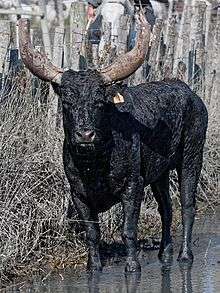Camargue cattle
 Young bull | |
| Conservation status | FAO (2007): not at risk[1]:41 |
|---|---|
| Other names | Raço di Biòu |
| Country of origin | France |
| Distribution | |
| Standard | French |
| Use | |
| Traits | |
| Weight | Male: 400 kg[2] |
| Female: 250 kg[2] | |
| Height | Male: 125 cm[2] |
| Female: 115 cm[2] | |
| Coat | black |
| Horn status | horned in both sexes |
| Notes | |
| semi-feral | |
|
Cattle Bos (primigenius) taurus | |

The Camargue is a breed of domestic cattle native to the Camargue marshlands of the river delta of the Rhône in southern France. It used for the traditional sport of course camarguaise, a kind of bloodless bull-fight, but not for the corrida, Iberian-style bull-fighting. It is one of two cattle breeds raised in semi-feral conditions in the Camargue; the other is the Brava or Race de Combat, a fighting breed. Since 1996 it has been officially known as the Provençal: Raço di Biòu.
History
The Raço di Biòu has long been raised in semi-feral conditions in the wetlands of the Camargue, in the département of Bouches-du-Rhône in the region of Provence-Alpes-Côte d'Azur, and of the Petite Camargue, in the département of Gard in the region of Occitanie. It is one of two cattle breeds raised in the area, the other being the Brava or Race de Combat, a fighting breed. Both are associated with the rural and cultural traditions of the Camargue, including the gardians, mounted herders who manage the livestock in manades, and the small white Camargue horses they ride.[3]
In 1996 beef from the two breeds of the Camargue, or from cross-breeds between them, received Appellation d’Origine Contrôlée status as "Taureau de Camargue". The name of the Camargue breed was changed to Raço di Biòu, and a herd-book was established.[4]:147[5]:99[6][7]
The population in 2004 was estimated at 5950.[2] In 2014 it was reported to be 5332.[8]
Characteristics
The Raço di Biòu is uniformly black, or occasionally dark brown.[4]:147 The mucous membranes are dark.[2] The horns are large; they are grey at the base, creamy white in the middle, and dark at the tips.[2][9]:186
Use and management

The Raço di Biòu is raised principally for the traditional sport of the course camarguaise, a type of bloodless bull-running in which castrated bullocks are used. In the ring, raseteurs must try to remove a cockade from the forehead of the bull. The bullocks are driven on foot to the arena by mounted gardians (the abrivado), and returned to the manade in the same way (the bandido).[3]
The meat of the Raço di Biòu, along with that of the Brava cattle breed and crosses between the two, can under strict conditions of pasturage and of zone and methods of production be marketed with the Appellation d'Origine Contrôlée certification of origin as "Taureau de Camargue"; animals that have appeared in the bull-ring are excluded.[6] Approximately 2000 head are sold each year for beef.[4]:147
The Raço di Biòu is managed extensively in the wetlands of the Camargue. The cattle are kept in manades, and herded by mounted gardians.[9]:187[10] The cattle contribute to the maintenance of large areas of Camargue wetland,[9]:183 and are also regarded as a tourist attraction.[2]
The administration of the Parc naturel régional de Camargue participates in several aspects of the management of the breed, including registration of births and matings, and organisation of course camarguaises.[11]
References
- ↑ Barbara Rischkowsky, D. Pilling (eds.) (2007). List of breeds documented in the Global Databank for Animal Genetic Resources, annex to The State of the World's Animal Genetic Resources for Food and Agriculture. Rome: Food and Agriculture Organization of the United Nations. ISBN 9789251057629. Accessed November 2016.
- 1 2 3 4 5 6 7 8 Étude de la race bovine: Raço di Bioù (in French). Bureau des Ressources Génétiques. Archived 7 June 2007.
- 1 2 "Les traditions camarguaises" (in French). Office de Tourisme Communauté de Communes du Pays de Lunel. 2011. Archived 22 March 2012.
- 1 2 3 Valerie Porter, Lawrence Alderson, Stephen J.G. Hall, D. Phillip Sponenberg (2016). Mason's World Encyclopedia of Livestock Breeds and Breeding (sixth edition). Wallingford: CABI. ISBN 9781780647944.
- ↑ Philippe Marchenay, Laurence Bérard (2016). Les produits de terroir: Entres cultures et règlements (in French). CNRS Éditions via OpenEdition. ISBN 9782271091093.
- 1 2 A.O.C. Viande « Taureau de Camargue » (in French). Parc naturel régional de Camargue. Archived 26 December 2004.
- ↑ "Présentation de la Filière bovine" (pdf) (in French). Chambre d’agriculture Bouches du Rhône. 2007. Archived 14 November 2008.
- ↑ Breed data sheet: Raço di Biou/France. Domestic Animal Diversity Information System of the Food and Agriculture Organization of the United Nations. Accessed November 2016.
- 1 2 3 Marie Dervillé, Stéphane Patin, Laurent Avon (2009). Races bovines de France: origine, standard, sélection (in French). Paris: Éditions France Agricole. ISBN 9782855571515.
- ↑ Nacioun Gardians (Cultural association, Camargue, France)
- ↑ Agriculture et environnement (in French). Parc naturel régional de Camargue. Accessed November 2016.
![]() Media related to Camargue cattle at Wikimedia Commons
Media related to Camargue cattle at Wikimedia Commons